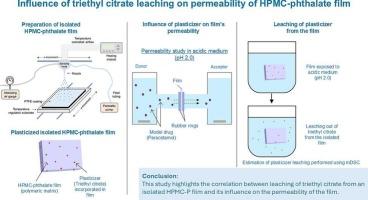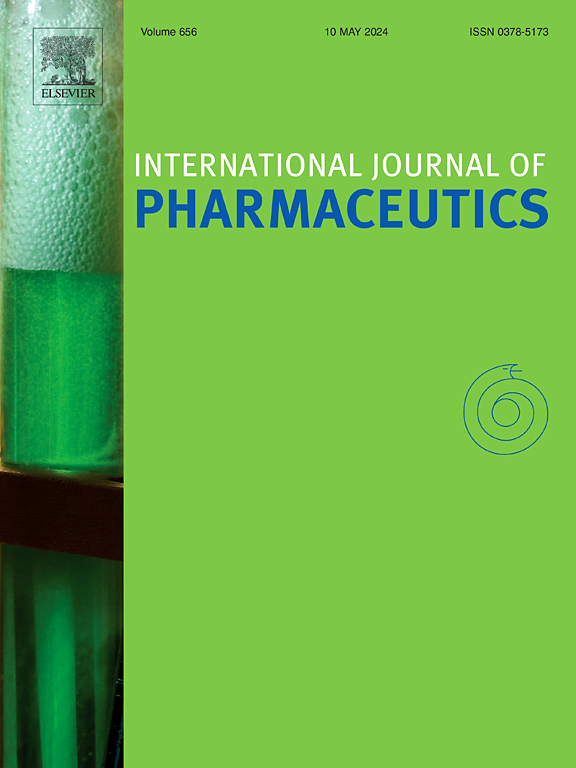The impact of triethyl citrate leaching from HPMC-phthalate based isolated films on film permeability and thermal properties
IF 5.2
2区 医学
Q1 PHARMACOLOGY & PHARMACY
引用次数: 0
Abstract
The primary objective of this study was to investigate to what extent triethyl citrate (TEC), a commonly used plasticizer, was leached from hydroxypropyl methylcellulose phthalate (HPMC-P)-based isolated films and how this affects the permeability of the film for the model drug acetaminophen. The effect of the plasticizer on the glass transition temperature (Tg) of HPMC-P films was studied using modulated differential scanning calorimetry (mDSC) and utilized to estimate the extent of plasticizer leaching. A linear relationship between the Tg of the film and the weight proportion of the plasticizer was established and applied to develop a calibration curve, which enabled the quantification of plasticizer leaching from the isolated films. The leaching profiles of the plasticizer obtained from mDSC analysis demonstrated a slow migration from the film, 10 % w/w TEC films took nearly 24 h to completely leach out the plasticizer (95.1 ± 10.6 %) from the film, whereas 20 % w/w TEC films had leached out 76.7 ± 12.64 % of plasticizer within the similar exposure time. A concentration-dependent, slow leaching of plasticizer was observed, where films with a higher plasticizer content exhibited a reduced rate of leaching. This finding was consistent with the observed percentage of mass loss and the medium uptake capacity study of the films. Moreover, the addition of plasticizer at a concentration of 10 % w/w provided a permeability coefficient of 1.35 ± 0.19 e-06 (cm/s), while 20 % w/w yielded a coefficient of 1.97 ± 0.40 e-06 (cm/s), which directly contributed to an increase in the film’s permeability compared to the films without plasticizer (1.19 ± 0.11 e-06 cm/s).

从hpmc -邻苯二甲酸酯基分离膜中浸出柠檬酸三乙酯对膜透性和热性能的影响。
本研究的主要目的是研究柠檬酸三乙酯(TEC),一种常用的增塑剂,在多大程度上从邻苯二甲酸羟丙基甲基纤维素(HPMC-P)基分离膜中浸出,以及这如何影响模型药物对乙酰氨基酚的膜的通透性。采用调制差示扫描量热法(mDSC)研究了增塑剂对HPMC-P薄膜玻璃化转变温度(Tg)的影响,并利用增塑剂的浸出程度进行了估算。建立了膜的Tg与增塑剂的质量比例之间的线性关系,并应用该关系建立了校准曲线,从而实现了从分离膜中浸出增塑剂的定量。塑化剂的浸出概要文件获得mDSC分析演示了一个缓慢的迁移从电影, % 10 w / w侦探电影花了近24 h 完全浸出塑化剂(95.1 ±10.6 %)的电影,而20 % 76.7 w / w侦探电影淋溶了 ±12.64 %中的塑化剂类似的曝光时间。一个浓度依赖,缓慢的浸出增塑剂被观察到,其中具有较高的增塑剂含量的薄膜显示出浸出率降低。这一发现与观察到的质量损失百分比和膜的介质吸收能力研究一致。此外,添加塑化剂的浓度10 %提供渗透系数为1.35 w / w ±0.19 e-06 (cm / s),尽管 % 20 w / w系数1.97 ±0.40 e-06 (cm / s),直接导致了电影的渗透率的增加相比,电影没有塑化剂(1.19 ±0.11 e-06 cm / s)。
本文章由计算机程序翻译,如有差异,请以英文原文为准。
求助全文
约1分钟内获得全文
求助全文
来源期刊
CiteScore
10.70
自引率
8.60%
发文量
951
审稿时长
72 days
期刊介绍:
The International Journal of Pharmaceutics is the third most cited journal in the "Pharmacy & Pharmacology" category out of 366 journals, being the true home for pharmaceutical scientists concerned with the physical, chemical and biological properties of devices and delivery systems for drugs, vaccines and biologicals, including their design, manufacture and evaluation. This includes evaluation of the properties of drugs, excipients such as surfactants and polymers and novel materials. The journal has special sections on pharmaceutical nanotechnology and personalized medicines, and publishes research papers, reviews, commentaries and letters to the editor as well as special issues.

 求助内容:
求助内容: 应助结果提醒方式:
应助结果提醒方式:


